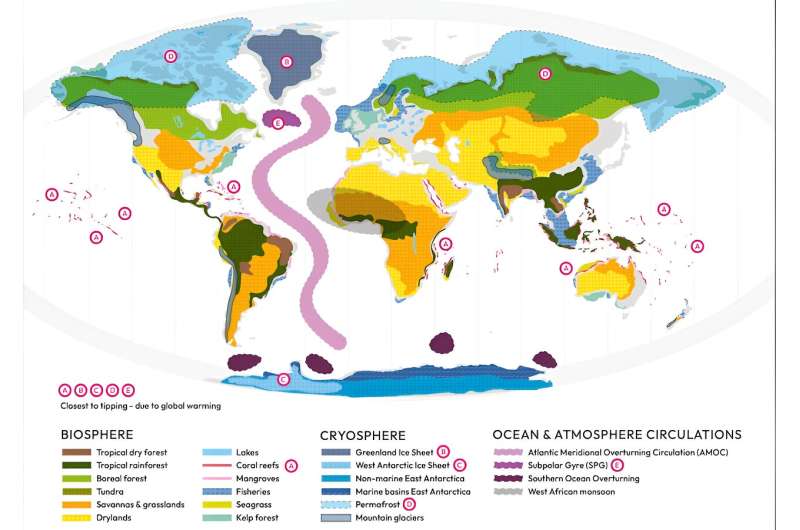
Most people expect that if a system, like someone’s body, an ecosystem, or part of the climate system, becomes stressed, it’ll respond fairly predictably—double the pressure, double the impact, and so on. This holds in many cases, but is not always true. Sometimes a system under stress changes steadily (or “linearly”) up to a point, but beyond that far bigger or abrupt changes can be locked in.
An example of such “nonlinear” changes are “tipping points”, which happen when a system is pushed past a threshold beyond which change becomes self-sustaining. This means that even if the original pressure eased off the change would keep on going until the system reaches a sometimes completely different state.
Having scoured scientific evidence of past and current changes, and factored in projections from computer models, we have identified more than 25 tipping points in the Earth system.
Six of these are in the icebound parts of the planet (the “cryosphere”), including the collapse of massive ice sheets in Greenland and different parts of Antarctica, as well as localized tipping in glaciers and thawing permafrost. Sixteen are in the “biosphere”—the sum of all the world’s ecosystems—including trees dying on a massive scale in parts of the Amazon and northern boreal forests, degradation of savannas and drylands, nutrient overloading of lakes, coral reef mass mortality, and many mangroves and seagrass meadows dying off.
Finally, we identified four potential tipping points in the circulation of the oceans and atmosphere, including collapse of deep ocean mixing in the North Atlantic and in the Southern Ocean around Antarctica, and disruption of the West African monsoon.
Human activities are already pushing some of these close to tipping points. The exact thresholds are uncertain, but at today’s global warming of 1.2°C, the widespread loss of warm water coral reefs is already becoming likely, while tipping in another four vital climate systems is possible. These are Greenland and West Antarctic ice sheet collapse, North Atlantic circulation collapse, and widespread localized thaw of permafrost.
There is also the potential for negative tipping in human societies, causing further financial instability, displacement, conflict or polarization. These would hamper our efforts to limit further Earth system tipping points, and could even bring about a shift to a social system characterized by greater authoritarianism, hostility and alienation that could entirely derail sustainability transitions.
A further risk is that most of Earth’s tipping systems interact in ways that destabilize one another. In the worst case, tipping one system makes connected systems more likely to tip too. This could produce a “tipping cascade” like falling dominoes.
The Global Tipping Points Report makes clear that climate change is a key driver for most of these tipping points, and the risk of crossing them can be reduced by urgently cutting greenhouse gas emissions to zero (which “positive tipping points” could accelerate). To help prevent tipping points in the biosphere, we’ll also need to rapidly reduce habitat loss and pollution while supporting ecological restoration and sustainable livelihoods.
Ambitious new governance approaches are needed. Our report recommends international bodies like the UN’s climate talks urgently start taking tipping points into account. Their understanding of dangerous climate change needs a serious update.